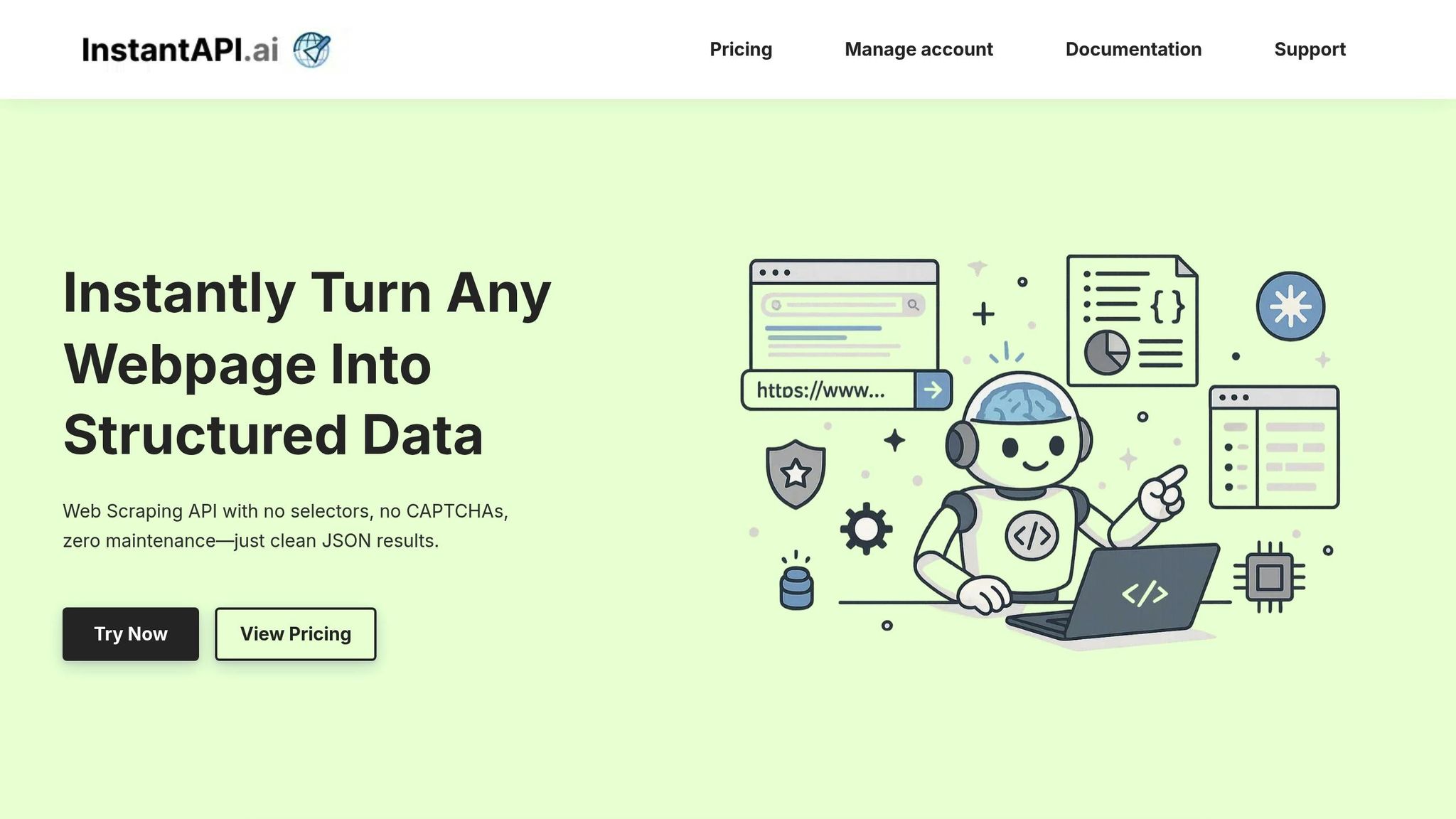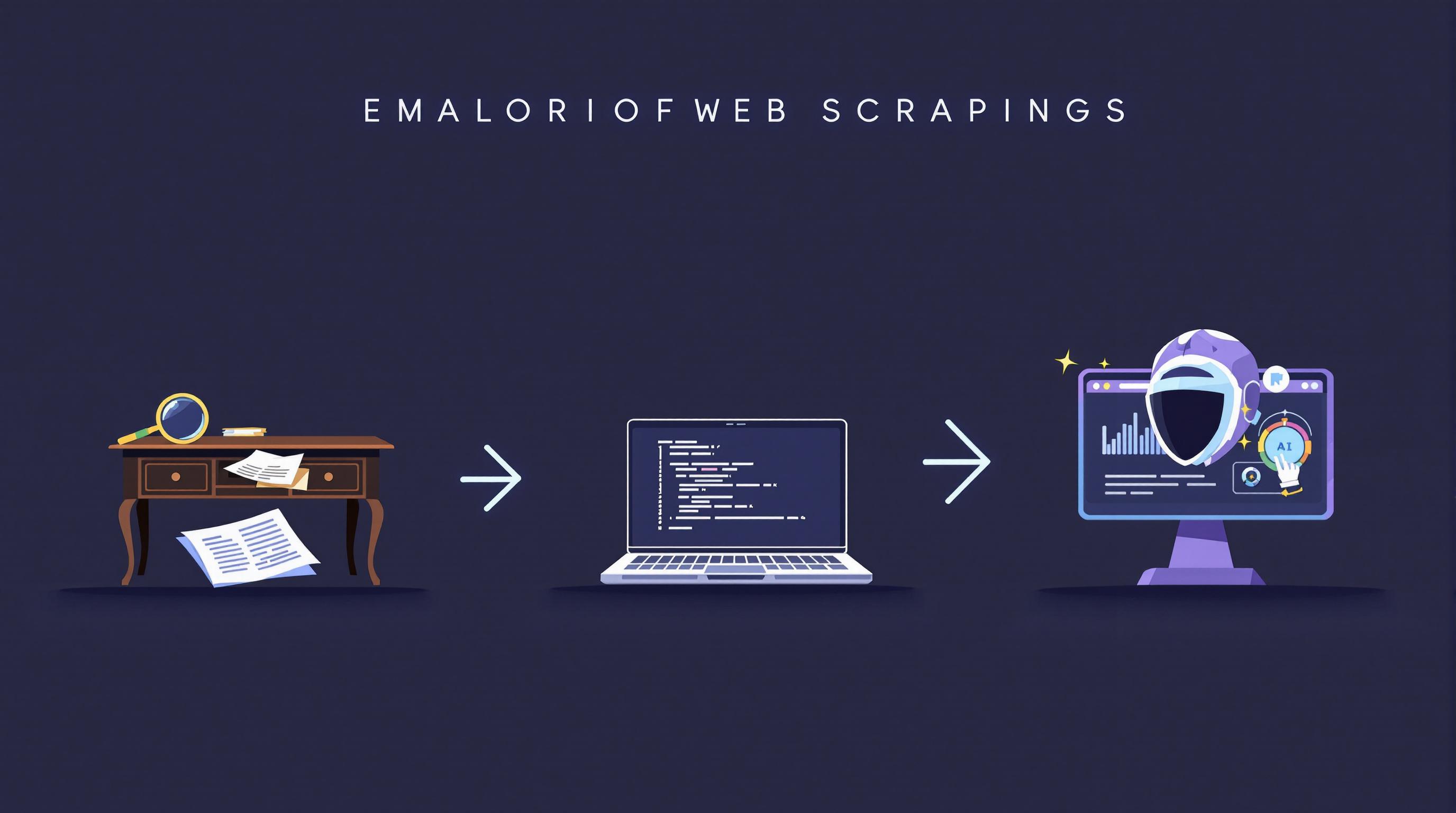Web scraping makes collecting election data easier, faster, and more detailed, helping campaigns and analysts make better decisions. Here's what you need to know:
- Why It Matters: Web scraping automates data collection, offering real-time updates, broad coverage, and insights into voter behavior.
- Top Tools: Use tools like Beautiful Soup for static sites, Scrapy for large-scale scraping, and InstantAPI.ai for real-time data collection.
- Challenges: Overcome issues like CAPTCHAs, dynamic content, and inconsistent data formats with rotating proxies, error handling, and data cleanup techniques.
- Legal and Ethical Rules: Always follow website guidelines, anonymize voter data, and manage server loads responsibly.
Quick Tip: For beginners, try tools like Google Sheets' ImportHTML or Dataminer. Advanced users can leverage frameworks like Scrapy or headless browsers like Playwright.
| Tool | Best Use Case | Cost Example |
|---|---|---|
| Beautiful Soup | Simple HTML parsing | Free |
| Scrapy | Large-scale scraping | Free (requires setup) |
| InstantAPI.ai | Real-time election data scraping | $2 per 1,000 pages scraped |
Web scraping is a powerful way to analyze elections, but it requires careful planning, the right tools, and adherence to ethical standards.
Web Scraping Tools for Election Data
Key Scraping Tools
Automated tools make collecting election data faster and more reliable, turning complex processes into manageable tasks.
Here are some standout tools for election data scraping:
- Beautiful Soup: Ideal for parsing HTML and XML from static websites, like state election board pages or local government portals with straightforward structures.
- Scrapy: A powerful framework for large-scale data collection. Its asynchronous processing is perfect for gathering real-time election results across multiple districts.
- InstantAPI.ai: A budget-friendly option, offering competitive rates to accommodate campaigns of all sizes.
These tools help political analysts gather timely, relevant election data to drive informed decisions.
Scraping Different Website Types
Election websites come in various forms, and the right approach depends on the site's complexity. From simple HTML pages to dynamic, JavaScript-heavy platforms, each type requires a tailored scraping method.
| Website Type | Recommended Tool | Key Consideration |
|---|---|---|
| Static HTML | Beautiful Soup | Straightforward HTML parsing |
| Dynamic JavaScript | Scrapy + Selenium | Handles AJAX and dynamic loading |
| Real-time Updates | InstantAPI.ai | Manages automated refreshes |
By matching the tool to the website type, you can ensure smooth and efficient data extraction.
Solving Common Problems
Even with the right tools, technical challenges can arise. Many election websites use CAPTCHA to block automated scrapers, but APIs with built-in CAPTCHA solving can help maintain consistent data flow.
Here are some tips to tackle common issues:
- Use rotating proxies and add delays to manage rate limits.
- Employ waiting mechanisms to capture dynamic content effectively.
- Implement error-handling strategies for failed requests to ensure smooth operations.
"For beginners, I would recommend using the ImportHTML function in Google Sheets and the Dataminer Chrome extension. Intermediate users might try web scraping APIs and tools like Parsehub. Advanced users should explore frameworks like Scrapy and headless browsers like Playwright."
The key to successful election data scraping lies in selecting the right tools, addressing technical hurdles, and respecting website access guidelines.
Processing Election Data
Getting Election Results
Processing election data involves organizing and extracting information systematically. When pulling data from state election websites, focus on gathering both current and historical records in a structured format. This typically includes vote counts, candidate details, and precinct-level breakdowns.
Using pagination controls is crucial to track progress and ensure you’ve collected all available data.
| Data Source | Key Information | Common Challenges |
|---|---|---|
| State Election Boards | Precinct-level demographics, district boundaries | Data format inconsistencies |
| News Organizations | Exit poll demographics, trend analysis | API rate limits |
| Public Records | Voter registration patterns, turnout data | Complex PDF layouts |
After collection, the raw data must be standardized to enable accurate analysis.
Data Cleanup Steps
The 2014 midterm elections in Georgia highlighted how inconsistent formatting can complicate analysis. For example, Senator David Perdue’s name appeared in four different formats: "DAVID A. PERDUE", "DAVID A. PERDUE (R)", "DAVID A. PERDUE(R)", and "DAVID PERDUE (R)". Such discrepancies can skew results if not addressed.
To clean and standardize election data, focus on these key tasks:
- Standardize candidate names and dates (e.g., use the MM/DD/YYYY format for uniformity).
- Verify vote totals by cross-checking against reported aggregates to catch discrepancies.
- Resolve special character and encoding issues that may disrupt data processing.
Once cleaned, the data becomes ready for structured analysis.
Data Analysis Setup
With standardized data in hand, convert it into Pandas DataFrames to simplify analysis and visualization.
-
Data Structure Creation
Organize your dataset into logical categories. Define consistent column names and data types to ensure compatibility with analysis tools. This step lays the groundwork for seamless integration with visualization platforms. -
Analysis Framework
Use your structured data to identify voting patterns and trends. As Anna Carmichael from Civis Analytics explains:"Analytics gives campaigns the power to make decisions, and to also evolve those decisions. You're able to … re-assess assumptions about what is happening. That brings more efficiency, and is more equitable by showing what is really going on with the American voters beyond 10 people in a room."
-
Visualization Preparation
Prepare your cleaned data for visualization by formatting it according to platform requirements. Here’s a quick overview:Platform Required Format Best Use Case Tableau CSV/Excel Interactive dashboards Power BI CSV/Excel/SQL Real-time monitoring Python (Matplotlib) DataFrame Custom visualizations
"The main decision a campaign has to make is allocation of resources. Resources are always scarce, and the question is how to allocate them."
- Kimball Brace, president of Election Data Services
Legal and Ethics Guidelines
Website Access Rules
When scraping election data, staying within legal boundaries is non-negotiable. The landmark HiQ Labs v. LinkedIn case clarified that scraping publicly available data does not violate the Computer Fraud and Abuse Act (CFAA). However, this doesn’t mean you have free rein to scrape any data you find.
Here are some key compliance steps to follow:
| Access Component | Required Action | Impact |
|---|---|---|
| Robots.txt | Check website.com/robots.txt | Identifies areas allowed or restricted |
| Terms of Service | Review for "scraping" clauses | Defines contractual obligations |
| HTTP Headers | Monitor X-Robots-Tag | Indicates scraping permissions |
The 2022 Meta v. Bright Data case further emphasized that publicly available data is generally fair game, but anything behind login walls requires explicit permission. Ensuring compliance with these rules is just the first step; safeguarding privacy is equally critical.
Private Data Protection
The scale of voter data is immense. For example, the Voter Reference Foundation manages information on over 161 million voters across 32 states and Washington, D.C. This highlights the importance of ethical data handling.
"We know from experience that publication of addresses of voters online can be utilized and has been utilized to harass, dox and even harm people."
- Shenna Bellows, Maine's secretary of state
To protect voter privacy and handle data responsibly:
- Anonymize voter data before storing it.
- Remove personal identifiers before conducting any analysis.
- Secure all collected data with robust protections.
- Document every step of your data handling process for accountability and transparency.
Server Load Management
Beyond legal and ethical considerations, responsible scraping also means managing server loads effectively. To avoid overwhelming servers:
- Use rate limiting to control the frequency of requests.
- Continuously monitor server response times for signs of strain.
- Adjust scraping speeds as necessary to minimize disruptions.
"Until Congress passes comprehensive legislation to regulate the handling of voter registration data by third-party organizations, the misuse of this data will continue."
- Christopher Bouzy, tech entrepreneur
sbb-itb-f2fbbd7
Next Steps
Main Points Review
Let’s revisit the essential aspects of effective election data scraping:
Web scraping has become a go-to method for gathering election data, offering a structured way to analyze political trends. However, success depends on a well-planned approach and strict adherence to ethical guidelines.
Key Components at a Glance
| Component | Implementation Focus | Impact |
|---|---|---|
| Data Collection | Start with basic tools, scale to advanced | Builds a solid and reliable data base |
| Legal Compliance | Follow robots.txt and website ToS | Ensures scraping remains sustainable |
| Data Protection | Apply anonymization protocols | Safeguards voter privacy |
| Server Management | Use rate limiting and monitoring | Avoids system overloads |
"Journalists should learn how the web works. Learning Python is a secret weapon in order to learn how to scrape the web. Thanks to its rich ecosystem, web scraping has never been so easy. Web scraping framework, data manipulation and visualization libraries, you name it!"
– Kevin Sahin, Co-Founder of ScrapingBee
By mastering these basics, you can take your data scraping efforts to the next level with tools like InstantAPI.ai.
Using InstantAPI.ai

InstantAPI.ai simplifies election data scraping by automating the process, offering real-time updates, and delivering structured data outputs - all at an affordable rate of $2 per 1,000 pages scraped. It aligns with the principles of ethical and efficient data collection while boosting productivity.
Real-Time Data Integration
With InstantAPI.ai, you can automate the extraction of election data in real time. It handles JavaScript-heavy websites and uses premium proxies to ensure uninterrupted access to election results.
Customizable Data Extraction
The platform allows you to focus on key election metrics, such as:
- Voter turnout figures
- Candidate performance stats
- Demographic breakdowns
- Precinct-level results
At just $2 per 1,000 pages, this AI-powered tool offers a budget-friendly way to integrate structured election data into your analysis.
For instance, in May 2023, Andy Dickinson demonstrated the power of automated election data scraping by extracting ward-level results, including electorate numbers and turnout statistics. This example highlights how structured data can lead to deeper political insights.
Data Visualization and Web Scraping with Python on US 2020 Presidential Elections
FAQs
How can I legally and ethically scrape election data for political analysis?
To ensure your web scraping efforts for election data remain within legal and ethical boundaries, start by targeting data that is publicly accessible. Avoid scraping information hidden behind paywalls, requiring user authentication, or restricted by terms of service, as these actions could lead to legal complications. Make sure you're familiar with U.S. laws regarding web scraping, which may include risks like copyright violations or breaches of contract. Since the legal landscape is fragmented, staying informed and cautious is key.
On the ethical side, prioritize respecting privacy and intellectual property. Review the website's robots.txt file to understand any limitations or permissions regarding scraping activities. When possible, reach out to website administrators to request permission. By taking these precautions, you can responsibly collect election data while staying aligned with both legal requirements and ethical standards.
How can I handle dynamic content and CAPTCHAs when scraping election websites?
Scraping Election Websites with Dynamic Content and CAPTCHAs
Scraping election websites that feature dynamic content and CAPTCHAs can be challenging, but with the right tools and methods, it becomes manageable. Start by using browser automation tools like Selenium or Puppeteer. These tools simulate human behavior, making it easier to navigate complex pages and interact with dynamic elements.
When it comes to CAPTCHAs, integrating CAPTCHA-solving services like 2Captcha can save time and effort by automating the process. To avoid getting blocked, implement proxy rotation. This spreads your requests across different IP addresses, reducing the likelihood of detection.
By combining these strategies, you can extract data more efficiently while respecting website rules and minimizing interruptions.
How do I clean and standardize election data to ensure accurate analysis and avoid errors?
Cleaning and standardizing election data is a crucial step to ensure accurate analysis and minimize errors. Begin by formatting the data consistently - use the MM/DD/YYYY format for dates and ensure all text is in one language. Eliminate duplicates, irrelevant data, and inconsistencies, and make sure names for candidates, parties, and locations are standardized to maintain uniformity across the dataset.
For efficiency, consider using automated tools like Beautiful Soup or Scrapy to extract and clean the data. Afterward, always cross-check your dataset with official sources to verify its accuracy and reliability. This attention to detail is key when working with data that informs important political decisions.


